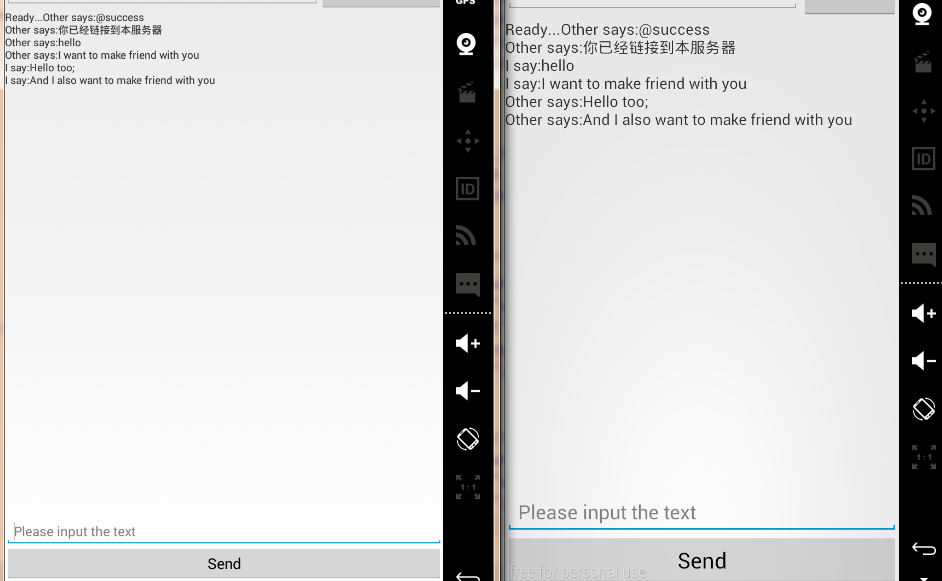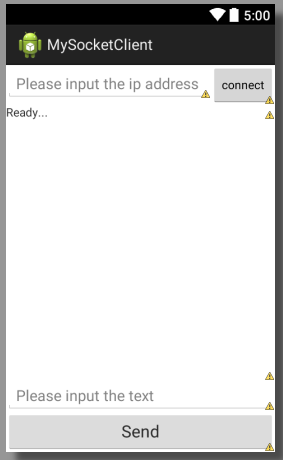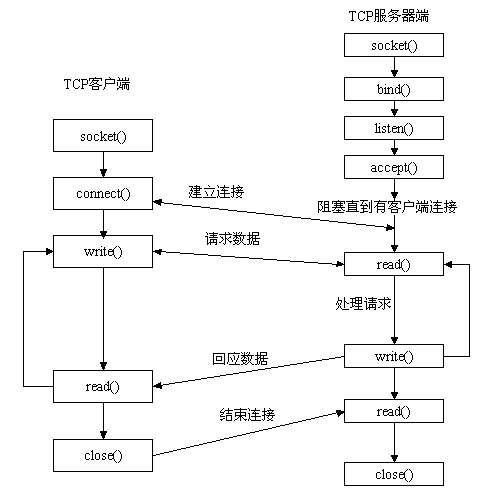上篇博客是对socket服务端的笔记,而本文则是我对socket客户端的一些笔记,客户端是在Android手机上。先给大家看看最后的效果吧。

首先是界面代码:
activity_main.xml
<LinearLayout
xmlns:android="http://schemas.android.com/apk/res/android"
xmlns:tools="http://schemas.android.com/tools"
android:layout_width="match_parent"
android:layout_height="match_parent"
android:orientation="vertical" >
<LinearLayout
android:layout_width="fill_parent"
android:layout_height="wrap_content"
android:orientation="horizontal"
>
<EditText
android:id="@+id/ip_ed"
android:layout_width="wrap_content"
android:layout_height="wrap_content"
android:inputType="text"
android:hint="Please input the ip address"
android:layout_weight="2"
/>
<Button
android:id="@+id/connect"
android:layout_width="wrap_content"
android:layout_height="wrap_content"
android:layout_weight="1"
android:textSize="14sp"
android:text="connect"/>
</LinearLayout>
<ScrollView
android:layout_width="match_parent"
android:layout_height="wrap_content"
android:layout_weight="5">
<TextView
android:id="@+id/display_text"
android:layout_width="fill_parent"
android:layout_height="fill_parent"
android:text="Ready..."/>
</ScrollView>
<EditText
android:id="@+id/send_text"
android:layout_width="fill_parent"
android:layout_height="wrap_content"
android:inputType="text"
android:hint="Please input the text"
/>
<Button
android:id="@+id/btn_send"
android:layout_width="fill_parent"
android:layout_height="wrap_content"
android:text="Send"
android:textSize="20sp"/>
</LinearLayout>
大概就长这样—

这里就不详述界面代码了,下面进入功能代码
MainActivity.java
import java.io.BufferedReader;
import java.io.BufferedWriter;
import java.io.IOException;
import java.io.InputStreamReader;
import java.io.OutputStreamWriter;
import java.net.Socket;
import java.net.UnknownHostException;
import android.app.Activity;
import android.os.AsyncTask;
import android.os.Bundle;
import android.view.Menu;
import android.view.MenuItem;
import android.view.View;
import android.widget.Button;
import android.widget.EditText;
import android.widget.TextView;
import android.widget.Toast;
public class MainActivity extends Activity {
EditText ip;
EditText input_text;
TextView text;
Button btn_connect, btn_send;
@Override
protected void onCreate(Bundle savedInstanceState) {
super.onCreate(savedInstanceState);
setContentView(R.layout.activity_main);
ip = (EditText) findViewById(R.id.ip_ed);
input_text = (EditText) findViewById(R.id.send_text);
text = (TextView) findViewById(R.id.display_text);
btn_connect = (Button) findViewById(R.id.connect);
btn_send = (Button) findViewById(R.id.btn_send);
btn_connect.setOnClickListener(new View.OnClickListener() {
@Override
public void onClick(View v) {
connect();
}
});
btn_send.setOnClickListener(new View.OnClickListener() {
@Override
public void onClick(View v) {
send();
}
});
}
/*******************************************************/
Socket socket = null;
BufferedWriter writer = null;
BufferedReader reader = null;
public void connect() {
AsyncTask<Void, String, Void> read = new AsyncTask<Void, String, Void>() {
@Override
protected Void doInBackground(Void... params) {
try {
socket = new Socket(ip.getText().toString(), 12345);
writer = new BufferedWriter(new OutputStreamWriter(
socket.getOutputStream()));
reader = new BufferedReader(new InputStreamReader(
socket.getInputStream()));
publishProgress("@success");
} catch (UnknownHostException e) {
Toast.makeText(MainActivity.this,
"Can't Connect the Server", Toast.LENGTH_LONG)
.show();
} catch (IOException e) {
Toast.makeText(MainActivity.this,
"Can't Connect the Server", Toast.LENGTH_LONG)
.show();
}
try {
String line;
while ((line = reader.readLine()) != null) {
publishProgress(line);
}
} catch (IOException e) {
e.printStackTrace();
}
return null;
}
@Override
protected void onProgressUpdate(String... values) {
if (values[0].equals("@success")) {
Toast.makeText(MainActivity.this, "Success to connect",
Toast.LENGTH_LONG).show();
}
text.append("Other says:" + values[0] + "\n");
super.onProgressUpdate(values);
}
};
read.execute();
}
public void send() {
try {
text.append("I say:" + input_text.getText().toString() + "\n");
writer.write(input_text.getText().toString() + "\n");
writer.flush();
input_text.setText("");
} catch (IOException e) {
e.printStackTrace();
}
}
}这里的重点就是两个button按钮事件,一个是连接操作,一个是发送操作。发送操作非常简单,即将EditText中的字符输出到加到TextView.text中去即可,当然你还必须将其写入到缓冲中去,因为其他的socket用户也要能接收到你发送的信息。最后flush()刷新下缓冲区的数据。
连接操作则首先是要创建一个socket,IP地址为本机的IP地址,端口号为服务端设置的端口号,这里又涉及的Android中一个非常重要的知识点AsyncTask,这里我不解释,之后我认真学习后再整理下笔记。这里就简单提下原理,doInBackground()完成读写缓冲区的数据,第一次连接会将@success这个字符串通过函数publishProgress传递给onProgressUpdate(),再通过该函数更新UI线程。由于我是在AsyncTask中创建了一个新的socket,就我们所知这个socket相当于ChatSocket是一个线程,故只要线程未结束,这个AsyncTask便一直在后台运行着,这时需要对socket通信有所了解,不了解的同学可以看 Android的socket通信
这张图还是要给大家看的

我们在代码中可以看到每次某个客户发送数据的时候都会使用到write(),向服务端请求了一个数据,然后服务端处理请求后会write()【见Android中socket的实例分析(一)的out()】。故onProgressUpdate()每次都会read()一个values[0]输出。
至此Android关于Socket的学习就告一段落了。






















 693
693

 被折叠的 条评论
为什么被折叠?
被折叠的 条评论
为什么被折叠?








